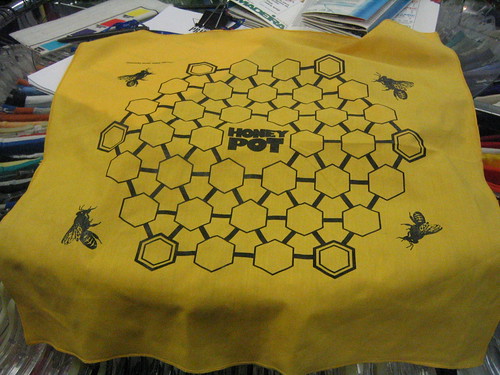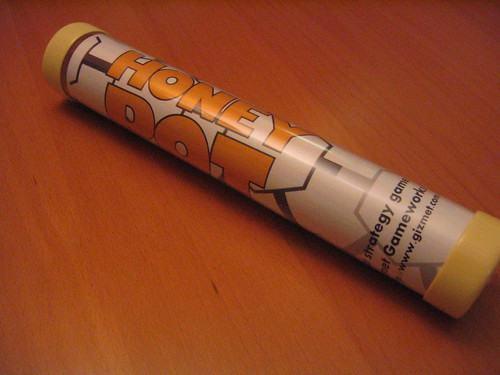The tubes are in.
The first official board game from Gizmet Gameworks is poised to hit the shelf. Well, the virtual shelf, anyway. After a long period of design and playtesting, the game that has been through more name changes than [insert relevant Hollywood serial divorcee here] is ready to go. I cemented in a couple of rules that made it through final testing, and I declared Honeypot “done” about a month or so ago. Now, all there was to do was make the damn thing, and get it into the hands of the waiting, game-hungry public.
Since this is my first game for sale, I’m leery about sinking thousands of dollars into a good-sized run – I don’t have that kind of money on hand to drop on a project that may or may not sail. So, I decided to limit myself to five hundred or so units at first. I drew up an extensive list of manufacturers, did research, got recommendations from other published developers, made spreadsheets, figured budgets, and finally wound up with a fairly cheap bid from a US-based manufacturer. Cheap at first look, at least – the price of just under nine bucks a unit (which is not bad for such a small run) did not take into account additional costs for setup, shipping, or actually using good parts. All told, my most inexpensive option was still around twenty bucks a pop, which was much too rich for my blood. Despair was on the horizon – I could figure out some way to do this, or sit around waiting for the fickle finger of a publisher to point my way.
As luck would have it, I found a way. Not as simple as getting someone in a factory in Parts Unknown to fill boxes with boxes and drop them on my doorstep, but within a much more realistic budget. I drew up a plan, did some more research, and started ordering parts to print up and assemble myself.
The basic components for Honeypot are the board and forty double-sided hex tokens, a rule sheet, and a box. Not too complicated, hm? Well, getting hex counters made with any kind of quality is first a pain in the ass, and secondly a pain in the money. So, I took it upon myself to port my token art to a new platform – 1″ white labels, stuck on either side of a 1 1/4″ wooden disc. Labor-intensive, to be sure, but not rocket science, so I can produce about two dozen games worth of game tokens in the course of a DVD – more, if I put Battlestar in the disc changer. These came out beautifully, especially after discovering that a totally decent color laser printer could be had for a very reasonable sum – an investment that will pay itself off many times over in the coming while or so.
Next was the board. I found a great source for cheap blank 18″ square folding game boards, but that would involve more printing and cutting and pasting and getting boxes that fit and packing those boxes in other boxes for shipping and storage and all sorts of other grief that I didn’t feel like dealing with. However, a solution was at hand! Inspired by the good folks at Pair-Of-Dice games, I realized that the Honeypot board would fit beautifully printed on a bandanna. I did a bit more research, and a bit of emailing – the same story as usual, cheap stuff required orders of several thousand. Fortunately, by widening my search, I located a local screen printer who could provide exactly what I needed at the price I needed, with a turnaround of less than a week. Brilliant. Board art updated, resized, and made ready for screen printing, and sent off – I went over to check out a proof print today, and it looks awesome. The first order will be ready tomorrow. Woo!

So, that just leaves packaging. I have a foldable and stuffable game board, a large handful of nice game pieces, and rules that fit on one side of a letter-sized page. I know what must be done. I whip up some cover art to go on the other side of the page (with logotype help from co-flywheeler Emerson), and begin my final edit of the rules (with much-appreciated input from Mischa, Dan, and the rest of our resident designers). This will be printed up double-sided on my swanky new color laser, and inserted into a clear plastic mailing tube, along with the lovely new cloth boards and candy-like “hex” tokens, and capped with yellow (or special edition red!) vinyl caps. Voila! A game that is attractive, economical, and pleasant to fondle.

As mentioned above, I just received moments ago two large cardboard boxes that contain my shipping tubes. The boards will be delivered here tomorrow afternoon, and at that point, the only thing standing between Honeypot and the clamoring masses are five minutes assembly time and twenty bucks. (Once I get the product page on gizmet.com built, anyway…) The initial run is only about a hundred and fifty pieces, so I can get a good sense of what demand might be like. The killer part of this production method is that I can have parts for any number of games ready to go in a week or so, now, so a surge of orders can be handled with ease – one might even go so far as to call the process “agile”, if one were so inclined.
If anyone has a case of morbid curiosity about any part of the research or production processes, my esteemed suppliers, or anything else regarding the game, feel free to drop me a line or leave a comment here. I’m looking forward to holding the first totally complete Honeypot package in my hand tomorrow, and I’m looking even more forward to everyone else holding one of their own. We ship!